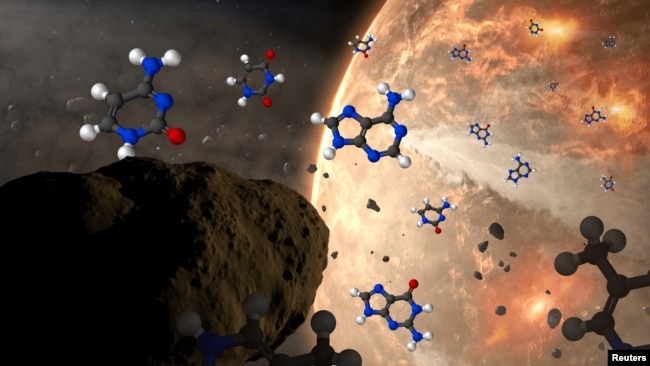生命誕生に必要な科学物質は宇宙から
”地球は、今から約46億年前、小さな惑星同士がぶつかり、だんだん大きくなって誕生した。さらに地球が冷えると、水蒸気が雨になって何年もの間降り続き海ができたのが約40億年前。そして、約38億〜35億年前には、地球最初の生命である細菌が誕生した。”
ご存知のように、学校で習う地球誕生です。
突然始まる生命の歴史。科学物質が発見されてもなお、生命誕生には懐疑的です。
異星人による宇宙の壮大なる実験場だったかも・・・?だとしたらその目的は?
VOAで今日も英語を学びましょう!!
生命にとって重要な化学物質が宇宙からやってきた可能性(和訳)
Important Chemicals for Life May Have Arrived from Space
May 05,2022
隕石の研究により、宇宙の岩石が地球に生命を誕生させるのに役立つ化学物質をもたらした可能性があることを示す証拠がさらに見つかりました。
研究対象となった隕石は、オーストラリア、カナダ、米国に落下したものです。
これらの隕石は、DNAとRNAを形成するのに必要な5つの化学成分のうち3つを含んでいることが、これまでの研究で明らかになっています。DNAは、生物の遺伝的命令を伝える分子です。RNAは遺伝子の操作に重要な分子です。
研究者たちは最近、最後の2つの化学物質を特定したと発表しました。
この情報は、北海道大学低温科学研究所の大場康弘氏から得たものです。大庭氏は、Nature Communications誌に掲載されたこの研究の主執筆者です。
この研究結果は、隕石が地球最初の生物の出現に必要な有機化合物の重要な供給源であった可能性を裏付けるものであると、メリーランド州にあるNASAゴダード宇宙飛行センターの共同執筆者ダニー・グラヴィン氏は述べています。
科学者たちは、化学化合物がどのように集まって、自己複製が可能な生物を形成したのかについて、より深く理解しようとしてきました。DNAとRNAの形成は、これらの分子が生物を構築し、操作するための命令を含んでいるため、重要な出来事であると考えられます。
「地球上の生命の起源に至る化学的なステップについては、まだ学ぶべきことがたくさんあります」とグラヴィン教授は述べています。さらに、「今回の研究によって、生命が誕生する前に地球上に存在していたであろう化学物質のリストが増えたことは確かです」とも語っています。
研究者らは、3つの隕石の物質を調べました。一つは1950年に米国ケンタッキー州のマレーの町の近くに落下したもの。もう一つは1969年にオーストラリアのビクトリア州のマーチソンという町の近くに落下したものです。最後の隕石は、2000年にカナダのブリティッシュコロンビア州のタギッシュ湖の近くに落下しました。
3つとも、太陽系の歴史の初期に形成されたと考えられる岩石質の物質でできています。マーチソン隕石とマレー隕石は重量比で約2パーセント、タギッシュ湖隕石は約4パーセントの有機炭素を含んでおり、炭素が豊富であることがわかります。炭素は地球上の生物の主成分です。
「3つの隕石はすべて、有機分子の非常に複雑な混合物を含んでおり、そのほとんどはまだ同定されていません。」とグラヴィン氏は言います。
地球は約45億年前に形成されました。その初期には、隕石や彗星などの宇宙からの物質が降り注いだのです。地球最初の生物は、海に生息する単純な微生物でした。最も古い化石は、約35億年前の海洋微生物の化石です。
今回の研究で発見された2つの化学成分は、シトシンとチミンと呼ばれるものです。
生命に必要な化学物質は、この5つだけではなかったはずです。他には、糖類、脂肪酸、タンパク質や酵素の成分であるアミノ酸などが必要でした。
大場氏は、「今回の結果は、『地球上の生命の誕生』を直接説明するものではないかもしれません。」と言います。しかし、生命が誕生する前の初期の地球上にどのような有機分子があったかを理解するのに役立つと彼は述べています。
Important Chemicals for Life May Have Arrived from Space
A study of meteorites has found more evidence that space rocks may have brought chemicals to Earth that helped start life on the planet.
The meteorites studied had landed in Australia, Canada and the United States.
Earlier research on the objects showed they contained three of the five chemical components necessary to form DNA and RNA. DNA is the molecule that carries genetic instructions in living things. RNA is the molecule important to the operation of genes.
Researchers said recently they have now identified the final two chemicals.
That information comes from Yasuhiro Oba of Hokkaido University's Institute of Low Temperature Science in Japan. Oba was the lead writer of the study that was published in Nature Communications.
The research findings support the idea that meteorites could have been an important source of organic compounds necessary for the emergence of Earth's first organisms, said study co-writer Danny Glavin of NASA's Goddard Space Flight Center in Maryland.
Scientists have been seeking to better understand how chemical compounds came together to form a living thing able to reproduce itself. The formation of DNA and RNA would be an important event as these molecules contain the instructions to build and operate organisms.
"There is still much to learn about the chemical steps that led to the origin of life on Earth," Glavin said. He added, "This research certainly adds to the list of chemical compounds that would have been present” on Earth before the emergence of life.
The researchers examined material from three meteorites. One fell in 1950 near the town of Murray in the U.S. state of Kentucky. Another fell in 1969 near the town of Murchison in Australia's Victoria state. The final meteorite fell in 2000 near Tagish Lake in the Canadian province British Columbia .
All three are made of rocky material thought to have formed early in the solar system's history. They are carbon-rich, with the Murchison and Murray meteorites containing about two percent organic carbon by weight and the Tagish Lake meteorite containing about four percent organic carbon. Carbon is a primary ingredient of organisms on Earth.
"All three meteorites contain a very complex mixture of organic molecules, most of which have not yet been identified," Glavin said.
Earth formed about 4.5 billion years ago. In its early days, it was hit by meteorites, comets and other material from space. The planet's first organisms were simple microbes in the seas. The earliest-known fossils are of marine microbial life dating to around 3.5 billion years ago.
The two chemical components discovered in the latest study are called cytosine and thymine.
The five would not have been the only chemical compounds necessary for life. Among other things needed were sugars, fatty acids, and amino acids, which are components of proteins and enzymes.
Oba said, "The present results may not directly” explain the beginning “of life on the Earth." But, it does help to understand what organic molecules were on the early Earth before life formed, he said.
Words in This Story
meteorite – n. a piece of rock or metal that has fallen to the ground from outer space
component –n. one of the parts of something (such as a system or mixture) : an important piece of something
organic – adj. of, relating to, or obtained from living things
emerge – v. to rise or appear from a hidden or unknown place or condition : to come out into view
microbe – n. an extremely small living thing that can only be seen with a microscope
fossil –n. something (such as a leaf, skeleton, or footprint) that is from a plant or animal which lived in ancient times and that you can see in some rocks
